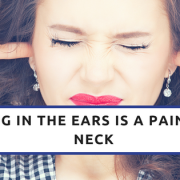Ringing in the Ears is a Pain in the Neck

Tinnitus is a problem where patients perceive sounds in the absence of sound stimuli. It afflicts between 10-15% of adults, but can be a severe hindrance in about 2% of the population. While tinnitus is classically thought of as a ringing sensation in the ears, there’s a wide variance to what patients perceive. Some describe it as a hissing, sizzinling, whooshing, or clicking.
The cause of tinnitus is known and well established in patients with hearing loss or those whose ears have been subject to noise trauma like loud music or blasts. However many patients experience tinnitus that can come out of the blue without a known cause. There is a growing amount of evidence that points to the neck as a unique source of ringing. Some have identified this type of tinnitus as cervicogenic somatic tinnitus (CST) and is estimated to make up almost 40% of all tinnitus cases.
How is My Hearing Related to My Neck?
It seems strange that a problem in your neck can interfere with normal hearing, but researchers have been trying to identify why people with tinnitus can get improvement from things like chiropractic or physical therapy interventions. A study in the journal Medical Hypothesis looked at the neurological connections between the neck and the hearing organ of the ear.
The authors showed that the nerve roots from all of the cervical spine all travel through the spinal cord and travel to the brainstem where your senses can integrate with some of the cells responsible for hearing. Cervical spine dysfunction has also been associated with blood flow problems, and some authors have hypothesized that dysfunction in the top vertebrae in the neck may affect blood flow to the brainstem and inner ear organs. When blood flow to these areas are compromised, then dysfunction from the ear can occur.
Problems like structural shifts in the neck or arthritis can agitate these sensory nerves and affect some of the brainstem regions that modulate your sense of hearing. This may be the reason why some patients can have ringing in the ears that lingers after things like whiplash and head injuries in sports even when there’s been no damage to the ears.

The neurological pathways that tie the neck to the hearing centers in the brain. Graphic from Bressi et al in Medical Hypothesis. 2017
Fortunately for many, research is also showing that addressing the neck can improve tinnitus in patients with some of the most disabling symptoms. A 2016 study in the journal Manual Therapy showed that treating the neck can lead to substantial improvements in up to 53% of patients with severe tinnitus.
Another study in 2018 showed that using both auditory and somatosensory stimulation can induce long lasting changes in the loudness and intrusiveness in tinnitus compared to just using one or the other.
Upper Cervical Chiropractic and Ear Problems
An interesting but little known fact is that chiropractic emerged in 1895 as a treatment for deafness. D.D. Palmer is credited with creating the chiropractic profession, and first performed an adjustment on a janitor with hearing loss named Harvey Lillard. It’s unclear what the circumstances of this first adjustment, but what is known is that Palmer thought he stumbled on the cure for deafness.
It’s obvious that chiropractic is not a cure or treatment for hearing loss otherwise our offices would be filled with the deaf and hard of hearing. However, current neuroscience research has helped us understand how several patients with hearing disorders like tinnitus can get relief from a neck procedure like the Atlas correction.
While it may not help every person with tinnitus, a thorough history and examination may be able to help us figure out if we can get that bothersome ringing out of your ears.


